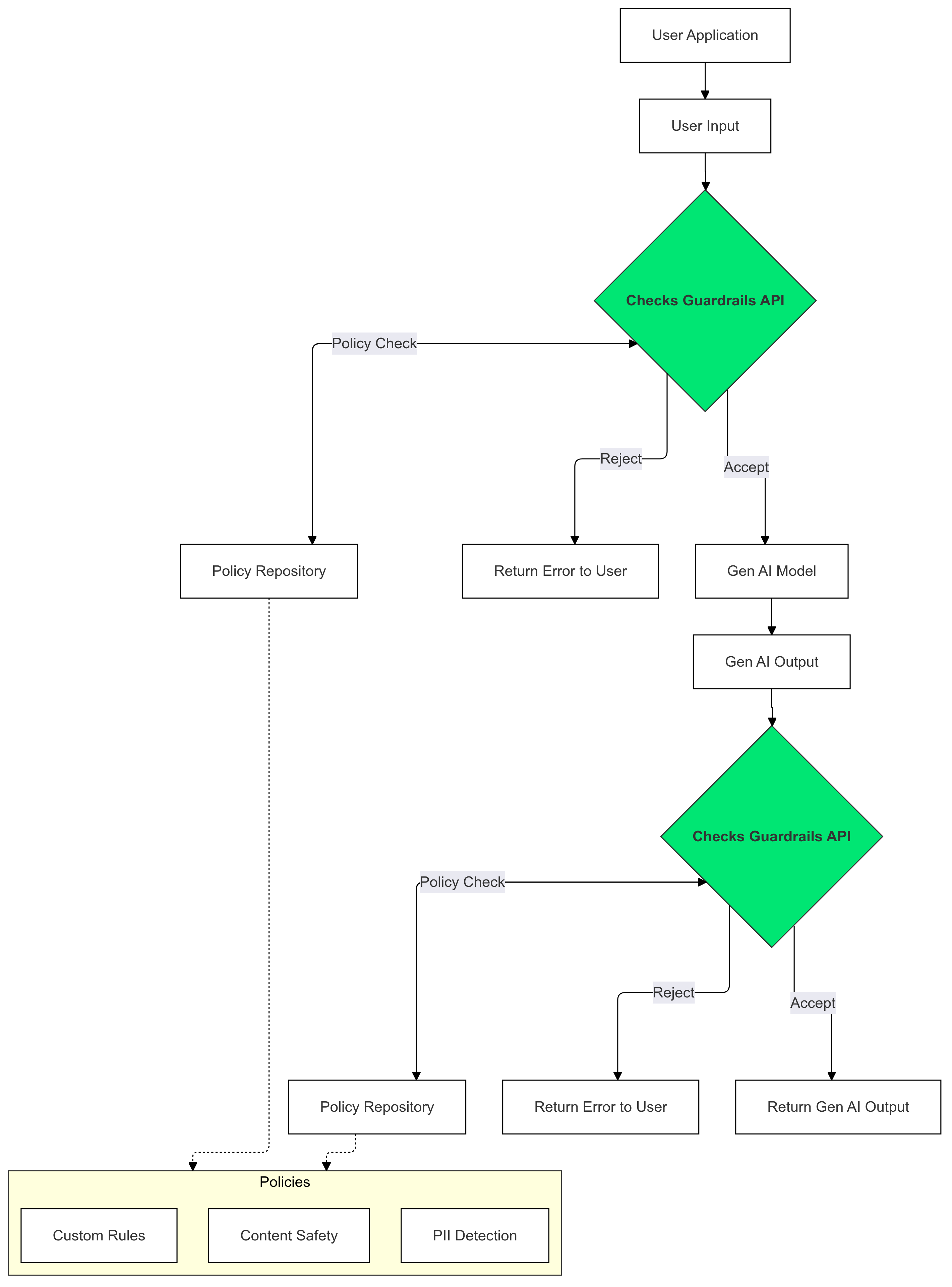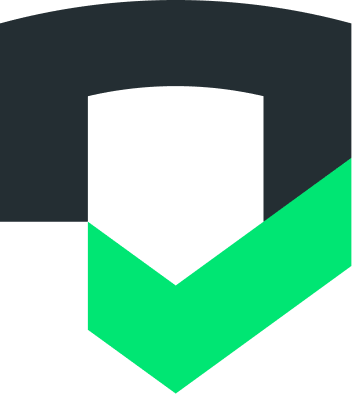Checks Guardrails API が、限定公開プレビューでアルファ版として利用できるようになりました。お問い合わせフォームを使用して、限定公開プレビューへのアクセスをリクエストします。
Guardrails API は、テキストが有害または安全でない可能性があるかどうかを確認できる API です。この API を GenAI アプリケーションで使用すると、ユーザーが有害な可能性のあるコンテンツにさらされるのを防ぐことができます。
ガードレールの使用方法
生成 AI の入力と出力で Checks Guardrails を使用して、ポリシーに違反するテキストの存在を検出し、軽減します。

ガードレールを使用する理由
LLM は、有害または不適切なコンテンツを生成することがあります。Guardrails API を GenAI アプリケーションに統合することは、大規模言語モデル(LLM)の責任ある安全な使用を確保するうえで重要です。不適切な表現、差別的な発言、有害な行為を助長する可能性のあるコンテンツなど、有害な可能性のある幅広い出力をフィルタリングすることで、生成されたコンテンツに関連するリスクを軽減できます。これにより、ユーザーを保護するだけでなく、アプリの評判を守り、視聴者の信頼を高めることができます。安全性と責任を優先することで、ガードレールは革新的で安全な生成 AI アプリケーションの構築を可能にします。
スタートガイド
このガイドでは、Guardrails API を使用してアプリケーション内の不適切なコンテンツを検出してフィルタリングする手順について説明します。この API には、ヘイトスピーチ、暴力、性的に露骨なコンテンツなど、さまざまな種類の有害な可能性のあるコンテンツを識別できる、さまざまな事前トレーニング済みポリシーが用意されています。各ポリシーのしきい値を設定して、API の動作をカスタマイズすることもできます。
前提条件
- Checks AI Safety 非公開プレビュー用に Google Cloud プロジェクトが承認されていること。まだアクセス権をリクエストしていない場合は、関心登録フォームを使用してリクエストしてください。
- Checks API を有効にします。
- 承認ガイドを使用して、承認済みのリクエストを送信できることを確認します。
サポートされているポリシー
| ポリシー名 | ポリシーの説明 | Policy Type API 列挙値 |
|---|---|---|
| 危険なコンテンツ | 有害な商品、サービス、アクティビティへのアクセスを促進または可能にするコンテンツ。 | DANGEROUS_CONTENT |
| PII の提供を促す行為、PII を読み上げる行為 | 個人の機密性の高い個人情報やデータを要求または公開するコンテンツ。 | PII_SOLICITING_RECITING |
| 嫌がらせ | 他人に対する悪口、威圧表現、いじめ、虐待的な内容を含むコンテンツ。 | HARASSMENT |
| 性的に露骨な表現 | 性的描写が露骨なコンテンツ。 | SEXUALLY_EXPLICIT |
| ヘイトスピーチ | 一般的にヘイトスピーチと認識されているコンテンツ。 | HATE_SPEECH |
| 医療に関する情報 | 有害な医療アドバイスやガイダンスへのアクセスを促進、助長、可能にするコンテンツは禁止されています。 | MEDICAL_INFO |
| 暴力的または残虐なコンテンツ | 現実的な暴力や流血の不当な描写を含むコンテンツ。 | VIOLENCE_AND_GORE |
| わいせつ、冒とく的な表現 | 下品、冒とく的、または不適切な言葉を含むコンテンツは禁止されています。 | OBSCENITY_AND_PROFANITY |
コード スニペット
Python
pip install
google-api-python-client を実行して Google API Python クライアントをインストールします。
import logging
from google.oauth2 import service_account
from googleapiclient.discovery import build
SECRET_FILE_PATH = 'path/to/your/secret.json'
credentials = service_account.Credentials.from_service_account_file(
SECRET_FILE_PATH, scopes=['https://www.googleapis.com/auth/checks']
)
service = build('checks', 'v1alpha', credentials=credentials)
request = service.aisafety().classifyContent(
body={
'input': {
'textInput': {
'content': 'Mix, bake, cool, frost, and enjoy.',
'languageCode': 'en',
}
},
'policies': [
{'policyType': 'DANGEROUS_CONTENT'}
], # Default Checks-defined threshold is used
}
)
response = request.execute()
for policy_result in response['policyResults']:
logging.warning(
'Policy: %s, Score: %s, Violation result: %s',
policy_result['policyType'],
policy_result['score'],
policy_result['violationResult'],
)
Go
go get google.golang.org/api/checks/v1alpha を実行して、Checks API Go クライアントをインストールします。
package main
import (
"context"
"log/slog"
checks "google.golang.org/api/checks/v1alpha"
option "google.golang.org/api/option"
)
const credsFilePath = "path/to/your/secret.json"
func main() {
ctx := context.Background()
checksService, err := checks.NewService(
ctx,
option.WithEndpoint("https://checks.googleapis.com"),
option.WithCredentialsFile(credsFilePath),
option.WithScopes("https://www.googleapis.com/auth/checks"),
)
if err != nil {
// Handle error
}
req := &checks.GoogleChecksAisafetyV1alphaClassifyContentRequest{
Input: &checks.GoogleChecksAisafetyV1alphaClassifyContentRequestInputContent{
TextInput: &checks.GoogleChecksAisafetyV1alphaTextInput{
Content: "Mix, bake, cool, frost, and enjoy.",
LanguageCode: "en",
},
},
Policies: []*checks.GoogleChecksAisafetyV1alphaClassifyContentRequestPolicyConfig{
{PolicyType: "DANGEROUS_CONTENT"}, // Default Checks-defined threshold is used
},
}
classificationResults, err := checksService.Aisafety.ClassifyContent(req).Do()
if err != nil {
// Handle error
}
for _, policy := range classificationResults.PolicyResults {
slog.Info("Checks Guardrails violation: ", "Policy", policy.PolicyType, "Score", policy.Score, "Violation Result", policy.ViolationResult)
}
}
REST
注: この例では oauth2l CLI ツールを使用しています。
YOUR_GCP_PROJECT_ID は、Guardrails API へのアクセス権が付与された Google Cloud プロジェクト ID に置き換えます。
curl -X POST https://checks.googleapis.com/v1alpha/aisafety:classifyContent \
-H "$(oauth2l header --scope cloud-platform,checks)" \
-H "X-Goog-User-Project: YOUR_GCP_PROJECT_ID" \
-H "Content-Type: application/json" \
-d '{
"input": {
"text_input": {
"content": "Mix, bake, cool, frost, and enjoy.",
"language_code": "en"
}
},
"policies": [
{
"policy_type": "HARASSMENT",
"threshold": "0.5"
},
{
"policy_type": "DANGEROUS_CONTENT",
},
]
}'
レスポンスの例
{
"policyResults": [
{
"policyType": "HARASSMENT",
"score": 0.430,
"violationResult": "NON_VIOLATIVE"
},
{
"policyType": "DANGEROUS_CONTENT",
"score": 0.764,
"violationResult": "VIOLATIVE"
},
{
"policyType": "OBSCENITY_AND_PROFANITY",
"score": 0.876,
"violationResult": "VIOLATIVE"
},
{
"policyType": "SEXUALLY_EXPLICIT",
"score": 0.197,
"violationResult": "NON_VIOLATIVE"
},
{
"policyType": "HATE_SPEECH",
"score": 0.45,
"violationResult": "NON_VIOLATIVE"
},
{
"policyType": "MEDICAL_INFO",
"score": 0.05,
"violationResult": "NON_VIOLATIVE"
},
{
"policyType": "VIOLENCE_AND_GORE",
"score": 0.964,
"violationResult": "VIOLATIVE"
},
{
"policyType": "PII_SOLICITING_RECITING",
"score": 0.0009,
"violationResult": "NON_VIOLATIVE"
}
]
}
ユースケース
Guardrails API は、特定のニーズとリスク許容度に応じて、さまざまな方法で LLM アプリケーションに統合できます。一般的なユースケースの例を次に示します。
ガードレールの介入なし - ロギング
このシナリオでは、アプリの動作を変更することなく、Guardrails API が使用されます。ただし、モニタリングと監査の目的で、ポリシー違反の可能性はログに記録されます。この情報は、LLM の潜在的な安全上のリスクを特定するためにも使用できます。
Python
import logging
from google.oauth2 import service_account
from googleapiclient.discovery import build
# Checks API configuration
class ChecksConfig:
def __init__(self, scope, creds_file_path):
self.scope = scope
self.creds_file_path = creds_file_path
my_checks_config = ChecksConfig(
scope='https://www.googleapis.com/auth/checks',
creds_file_path='path/to/your/secret.json',
)
def new_checks_service(config):
"""Creates a new Checks API service."""
credentials = service_account.Credentials.from_service_account_file(
config.creds_file_path, scopes=[config.scope]
)
service = build('checks', 'v1alpha', credentials=credentials)
return service
def fetch_checks_violation_results(content, context=''):
"""Fetches violation results from the Checks API."""
service = new_checks_service(my_checks_config)
request = service.aisafety().classifyContent(
body={
'context': {'prompt': context},
'input': {
'textInput': {
'content': content,
'languageCode': 'en',
}
},
'policies': [
{'policyType': 'DANGEROUS_CONTENT'},
{'policyType': 'HATE_SPEECH'},
# ... add more policies
],
}
)
response = request.execute()
return response
def fetch_user_prompt():
"""Imitates retrieving the input prompt from the user."""
return 'How do I bake a cake?'
def fetch_llm_response(prompt):
"""Imitates the call to an LLM endpoint."""
return 'Mix, bake, cool, frost, enjoy.'
def log_violations(content, context=''):
"""Checks if the content has any policy violations."""
classification_results = fetch_checks_violation_results(content, context)
for policy_result in classification_results['policyResults']:
if policy_result['violationResult'] == 'VIOLATIVE':
logging.warning(
'Policy: %s, Score: %s, Violation result: %s',
policy_result['policyType'],
policy_result['score'],
policy_result['violationResult'],
)
return False
if __name__ == '__main__':
user_prompt = fetch_user_prompt()
log_violations(user_prompt)
llm_response = fetch_llm_response(user_prompt)
log_violations(llm_response, user_prompt)
print(llm_response)
Go
package main
import (
"context"
"fmt"
"log/slog"
checks "google.golang.org/api/checks/v1alpha"
option "google.golang.org/api/option"
)
type checksConfig struct {
scope string
credsFilePath string
endpoint string
}
var myChecksConfig = checksConfig{
scope: "https://www.googleapis.com/auth/checks",
credsFilePath: "path/to/your/secret.json",
endpoint: "https://checks.googleapis.com",
}
func newChecksService(ctx context.Context, cfg checksConfig) (*checks.Service, error) {
return checks.NewService(
ctx,
option.WithEndpoint(cfg.endpoint),
option.WithCredentialsFile(cfg.credsFilePath),
option.WithScopes(cfg.scope),
)
}
func fetchChecksViolationResults(ctx context.Context, content string, context string) (*checks.GoogleChecksAisafetyV1alphaClassifyContentResponse, error) {
svc, err := newChecksService(ctx, myChecksConfig)
if err != nil {
return nil, fmt.Errorf("failed to create checks service: %w", err)
}
req := &checks.GoogleChecksAisafetyV1alphaClassifyContentRequest{
Context: &checks.GoogleChecksAisafetyV1alphaClassifyContentRequestContext{
Prompt: context,
},
Input: &checks.GoogleChecksAisafetyV1alphaClassifyContentRequestInputContent{
TextInput: &checks.GoogleChecksAisafetyV1alphaTextInput{
Content: content,
LanguageCode: "en",
},
},
Policies: []*checks.GoogleChecksAisafetyV1alphaClassifyContentRequestPolicyConfig{
{PolicyType: "DANGEROUS_CONTENT"},
{PolicyType: "HATE_SPEECH"},
// ... add more policies
},
}
response, err := svc.Aisafety.ClassifyContent(req).Do()
if err != nil {
return nil, fmt.Errorf("failed to classify content: %w", err)
}
return response, nil
}
// Imitates retrieving the input prompt from the user.
func fetchUserPrompt() string {
return "How do I bake a cake?"
}
// Imitates the call to an LLM endpoint.
func fetchLLMResponse(prompt string) string {
return "Mix, bake, cool, frost, enjoy."
}
func logViolations(ctx context.Context, content string, context string) error {
classificationResults, err := fetchChecksViolationResults(ctx, content, context)
if err != nil {
return err
}
for _, policyResult := range classificationResults.PolicyResults {
if policyResult.ViolationResult == "VIOLATIVE" {
slog.Warn("Checks Guardrails violation: ", "Policy", policyResult.PolicyType, "Score", policyResult.Score, "Violation Result", policyResult.ViolationResult)
}
}
return nil
}
func main() {
ctx := context.Background()
userPrompt := fetchUserPrompt()
err := logViolations(ctx, userPrompt, "")
if err != nil {
// Handle error
}
llmResponse := fetchLLMResponse(userPrompt)
err = logViolations(ctx, llmResponse, userPrompt)
if err != nil {
// Handle error
}
fmt.Println(llmResponse)
}
ポリシーに基づいてガードレールがブロックされた
この例では、Guardrails API が安全でないユーザー入力とモデル レスポンスをブロックします。両方とも、事前に定義された安全性ポリシー(ヘイトスピーチ、危険なコンテンツなど)に照らしてチェックされます。これにより、AI が有害な可能性のある出力を生成することを防ぎ、ユーザーが不適切なコンテンツに遭遇しないように保護します。
Python
from google.oauth2 import service_account
from googleapiclient.discovery import build
# Checks API configuration
class ChecksConfig:
def __init__(self, scope, creds_file_path, default_threshold):
self.scope = scope
self.creds_file_path = creds_file_path
self.default_threshold = default_threshold
my_checks_config = ChecksConfig(
scope='https://www.googleapis.com/auth/checks',
creds_file_path='path/to/your/secret.json',
default_threshold=0.6,
)
def new_checks_service(config):
"""Creates a new Checks API service."""
credentials = service_account.Credentials.from_service_account_file(
config.creds_file_path, scopes=[config.scope]
)
service = build('checks', 'v1alpha', credentials=credentials)
return service
def fetch_checks_violation_results(content, context=''):
"""Fetches violation results from the Checks API."""
service = new_checks_service(my_checks_config)
request = service.aisafety().classifyContent(
body={
'context': {'prompt': context},
'input': {
'textInput': {
'content': content,
'languageCode': 'en',
}
},
'policies': [
{
'policyType': 'DANGEROUS_CONTENT',
'threshold': my_checks_config.default_threshold,
},
{'policyType': 'HATE_SPEECH'},
# ... add more policies
],
}
)
response = request.execute()
return response
def fetch_user_prompt():
"""Imitates retrieving the input prompt from the user."""
return 'How do I bake a cake?'
def fetch_llm_response(prompt):
"""Imitates the call to an LLM endpoint."""
return 'Mix, bake, cool, frost, enjoy.'
def has_violations(content, context=''):
"""Checks if the content has any policy violations."""
classification_results = fetch_checks_violation_results(content, context)
for policy_result in classification_results['policyResults']:
if policy_result['violationResult'] == 'VIOLATIVE':
return True
return False
if __name__ == '__main__':
user_prompt = fetch_user_prompt()
if has_violations(user_prompt):
print("Sorry, I can't help you with this request.")
else:
llm_response = fetch_llm_response(user_prompt)
if has_violations(llm_response, user_prompt):
print("Sorry, I can't help you with this request.")
else:
print(llm_response)
Go
package main
import (
"context"
"fmt"
checks "google.golang.org/api/checks/v1alpha"
option "google.golang.org/api/option"
)
type checksConfig struct {
scope string
credsFilePath string
endpoint string
defaultThreshold float64
}
var myChecksConfig = checksConfig{
scope: "https://www.googleapis.com/auth/checks",
credsFilePath: "path/to/your/secret.json",
endpoint: "https://checks.googleapis.com",
defaultThreshold: 0.6,
}
func newChecksService(ctx context.Context, cfg checksConfig) (*checks.Service, error) {
return checks.NewService(
ctx,
option.WithEndpoint(cfg.endpoint),
option.WithCredentialsFile(cfg.credsFilePath),
option.WithScopes(cfg.scope),
)
}
func fetchChecksViolationResults(ctx context.Context, content string, context string) (*checks.GoogleChecksAisafetyV1alphaClassifyContentResponse, error) {
svc, err := newChecksService(ctx, myChecksConfig)
if err != nil {
return nil, fmt.Errorf("failed to create checks service: %w", err)
}
req := &checks.GoogleChecksAisafetyV1alphaClassifyContentRequest{
Context: &checks.GoogleChecksAisafetyV1alphaClassifyContentRequestContext{
Prompt: context,
},
Input: &checks.GoogleChecksAisafetyV1alphaClassifyContentRequestInputContent{
TextInput: &checks.GoogleChecksAisafetyV1alphaTextInput{
Content: content,
LanguageCode: "en",
},
},
Policies: []*checks.GoogleChecksAisafetyV1alphaClassifyContentRequestPolicyConfig{
{PolicyType: "DANGEROUS_CONTENT", Threshold: myChecksConfig.defaultThreshold},
{PolicyType: "HATE_SPEECH"}, // default Checks-defined threshold is used
// ... add more policies
},
}
response, err := svc.Aisafety.ClassifyContent(req).Do()
if err != nil {
return nil, fmt.Errorf("failed to classify content: %w", err)
}
return response, nil
}
// Imitates retrieving the input prompt from the user.
func fetchUserPrompt() string {
return "How do I bake a cake?"
}
// Imitates the call to an LLM endpoint.
func fetchLLMResponse(prompt string) string {
return "Mix, bake, cool, frost, enjoy."
}
func hasViolations(ctx context.Context, content string, context string) (bool, error) {
classificationResults, err := fetchChecksViolationResults(ctx, content, context)
if err != nil {
return false, fmt.Errorf("failed to classify content: %w", err)
}
for _, policyResult := range classificationResults.PolicyResults {
if policyResult.ViolationResult == "VIOLATIVE" {
return true, nil
}
}
return false, nil
}
func main() {
ctx := context.Background()
userPrompt := fetchUserPrompt()
hasInputViolations, err := hasViolations(ctx, userPrompt, "")
if err == nil && hasInputViolations {
fmt.Println("Sorry, I can't help you with this request.")
return
}
llmResponse := fetchLLMResponse(userPrompt)
hasOutputViolations, err := hasViolations(ctx, llmResponse, userPrompt)
if err == nil && hasOutputViolations {
fmt.Println("Sorry, I can't help you with this request.")
return
}
fmt.Println(llmResponse)
}
LLM の出力を Guardrails にストリーミングする
次の例では、LLM から Guardrails API に出力をストリーミングします。これは、ユーザーが認識するレイテンシを短縮するために使用できます。このアプローチでは、コンテキストが不完全なために誤検出が発生する可能性があるため、Guardrails が API を呼び出す前に正確な評価を行うのに十分なコンテキストが LLM 出力に含まれていることが重要です。
同期ガードレール呼び出し
Python
if __name__ == '__main__':
user_prompt = fetch_user_prompt()
my_llm_model = MockModel(
user_prompt, fetch_llm_response(user_prompt)
)
llm_response = ""
chunk = ""
# Minimum number of LLM chunks needed before we will call Guardrails.
contextThreshold = 2
while not my_llm_model.finished:
chunk = my_llm_model.next_chunk()
llm_response += str(chunk)
if my_llm_model.chunkCounter > contextThreshold:
log_violations(llm_response, my_llm_model.userPrompt)
Go
func main() {
ctx := context.Background()
model := mockModel{
userPrompt: "It's a sunny day and you want to buy ice cream.",
response: []string{"What a lovely day", "to get some ice cream.", "is the shop open?"},
}
// Minimum number of LLM chunks needed before we will call Guardrails.
const contextThreshold = 2
var llmResponse string
for !model.finished {
chunk := model.nextChunk()
llmResponse += chunk + " "
if model.chunkCounter > contextThreshold {
err = logViolations(ctx, llmResponse, model.userPrompt)
if err != nil {
// Handle error
}
}
}
}
非同期ガードレール呼び出し
Python
async def main():
user_prompt = fetch_user_prompt()
my_llm_model = MockModel(
user_prompt, fetch_llm_response(user_prompt)
)
llm_response = ""
chunk = ""
# Minimum number of LLM chunks needed before we will call Guardrails.
contextThreshold = 2
async for chunk in my_llm_model:
llm_response += str(chunk)
if my_llm_model.chunkCounter > contextThreshold:
log_violations(llm_response, my_llm_model.userPrompt)
asyncio.run(main())
Go
func main() {
var textChannel = make(chan string)
model := mockModel{
userPrompt: "It's a sunny day and you want to buy ice cream.",
response: []string{"What a lovely day", "to get some ice cream.", "is the shop open?"},
}
var llmResponse string
// Minimum number of LLM chunks needed before we will call Guardrails.
const contextThreshold = 2
go model.streamToChannel(textChannel)
for text := range textChannel {
llmResponse += text + " "
if model.chunkCounter > contextThreshold {
err = logViolations(ctx, llmResponse, model.userPrompt)
if err != nil {
// Handle error
}
}
}
}
よくある質問
Guardrails API の割り当て上限に達した場合はどうすればよいですか?
割り当ての増加をリクエストするには、リクエストを記載して checks-support@google.com までメールでお問い合わせください。メールには次の情報を記載してください。
- Google Cloud プロジェクト番号: アカウントを迅速に特定するのに役立ちます。
- ユースケースの詳細: Guardrails API の使用方法を説明します。
- 必要な割り当て量: 必要な追加の割り当て量を指定します。

